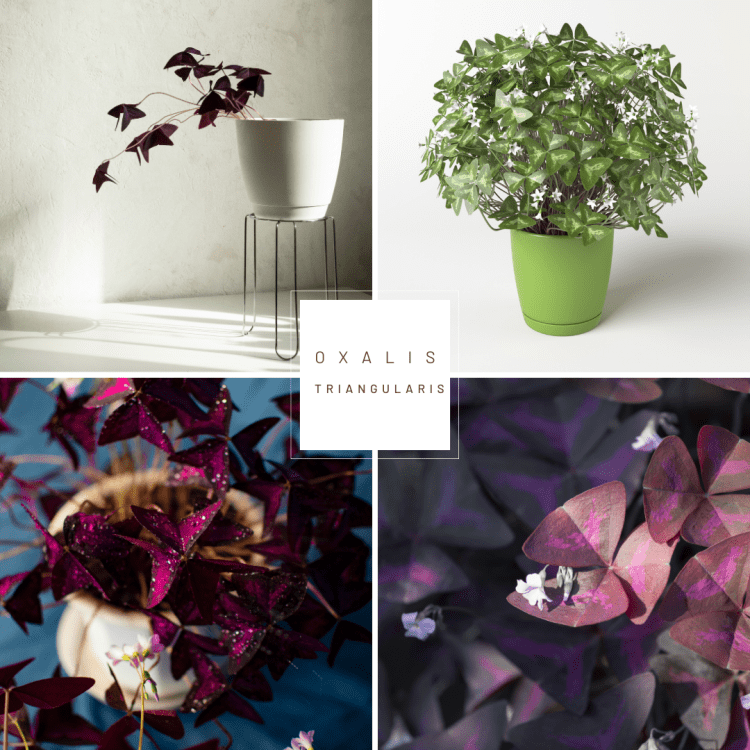I’ve mentioned before that I only started my houseplant collection in early 2023 while going through the Master Gardener’s Program. Honestly, I’ve always been so busy with my outdoor gardens, I’ve never had time to think about growing plants indoors. While going through class, I discovered a deep love for indoor plants! Suddenly I wanted ALL of them. Oxalis Triangularis was the first indoor plant that Art bought me. I had recently purchased my first Bromeliad and ordered a few common houseplants such as Pothos, Philodendron, Peperomia, Spider Plant, Ivy and Nerve Plant just to name a few.Art was in the habit of bringing me flowers nearly every weekend he would come to see me. He has always told me that his mom was a houseplant lady and she loved propagating plants. When he saw I was also developing a passion for house plants, he decided to change up his flower game.It was the weekend of Saint Patrick’s Day. He had stopped by the store on his way to my house and he saw a big display of these Shamrock Plants (their common name). I was elated when I saw it! Until that time, I was completely unfamiliar with this amazing plant. I told Art if he would prefer to spend his flower money on growing my houseplant collection, I would not object!!
While going through class, I discovered a deep love for indoor plants! Suddenly I wanted ALL of them. Oxalis Triangularis was the first indoor plant that Art bought me. I had recently purchased my first Bromeliad and ordered a few common houseplants such as Pothos, Philodendron, Peperomia, Spider Plant, Ivy and Nerve Plant just to name a few.Art was in the habit of bringing me flowers nearly every weekend he would come to see me. He has always told me that his mom was a houseplant lady and she loved propagating plants. When he saw I was also developing a passion for house plants, he decided to change up his flower game.It was the weekend of Saint Patrick’s Day. He had stopped by the store on his way to my house and he saw a big display of these Shamrock Plants (their common name). I was elated when I saw it! Until that time, I was completely unfamiliar with this amazing plant. I told Art if he would prefer to spend his flower money on growing my houseplant collection, I would not object!! I absolutely love my Oxalis and it has been growing nice and full all year. I recently made a video to share as I split the plant to create a new start for my grandma (she loves the color purple and I thought she would enjoy this plant).Oxalis triangularis, commonly known as the Purple Shamrock or Love Plant, is a charming and easy-to-grow houseplant with distinctive purple leaves. This guide will provide you with all the information you need to successfully care for Oxalis triangularis:1. Plant Overview:
I absolutely love my Oxalis and it has been growing nice and full all year. I recently made a video to share as I split the plant to create a new start for my grandma (she loves the color purple and I thought she would enjoy this plant).Oxalis triangularis, commonly known as the Purple Shamrock or Love Plant, is a charming and easy-to-grow houseplant with distinctive purple leaves. This guide will provide you with all the information you need to successfully care for Oxalis triangularis:1. Plant Overview:
 While going through class, I discovered a deep love for indoor plants! Suddenly I wanted ALL of them. Oxalis Triangularis was the first indoor plant that Art bought me. I had recently purchased my first Bromeliad and ordered a few common houseplants such as Pothos, Philodendron, Peperomia, Spider Plant, Ivy and Nerve Plant just to name a few.Art was in the habit of bringing me flowers nearly every weekend he would come to see me. He has always told me that his mom was a houseplant lady and she loved propagating plants. When he saw I was also developing a passion for house plants, he decided to change up his flower game.It was the weekend of Saint Patrick’s Day. He had stopped by the store on his way to my house and he saw a big display of these Shamrock Plants (their common name). I was elated when I saw it! Until that time, I was completely unfamiliar with this amazing plant. I told Art if he would prefer to spend his flower money on growing my houseplant collection, I would not object!!
While going through class, I discovered a deep love for indoor plants! Suddenly I wanted ALL of them. Oxalis Triangularis was the first indoor plant that Art bought me. I had recently purchased my first Bromeliad and ordered a few common houseplants such as Pothos, Philodendron, Peperomia, Spider Plant, Ivy and Nerve Plant just to name a few.Art was in the habit of bringing me flowers nearly every weekend he would come to see me. He has always told me that his mom was a houseplant lady and she loved propagating plants. When he saw I was also developing a passion for house plants, he decided to change up his flower game.It was the weekend of Saint Patrick’s Day. He had stopped by the store on his way to my house and he saw a big display of these Shamrock Plants (their common name). I was elated when I saw it! Until that time, I was completely unfamiliar with this amazing plant. I told Art if he would prefer to spend his flower money on growing my houseplant collection, I would not object!!
- Scientific Name: Oxalis triangularis
- Common Names: Purple Shamrock, Love Plant
- Native to: Brazil
- Plant Type: Perennial houseplant
- Oxalis triangularis prefers bright, indirect light. It should not receive direct sunlight, especially in hot summer months.
- Place it near a north or east-facing window to provide adequate light.
- Keep the temperature around 65-75°F (18-24°C) during the day and slightly cooler at night.
- Maintain a moderate humidity level. Regular indoor humidity is generally suitable, but occasional misting can help during dry periods.
- Water the plant when the top inch (2.5 cm) of the soil feels dry. It’s essential not to let the soil dry out completely.
- Be cautious not to overwater, as this can cause root rot. Allow excess water to drain from the pot to prevent standing water.
- Use a well-draining potting mix with a slightly acidic to neutral pH.
- Adding perlite or sand to the soil mix can help improve drainage.
- Feed your Oxalis triangularis with a balanced, liquid fertilizer diluted to half strength every 4-6 weeks during the growing season (spring and summer).
- Avoid fertilizing during the dormant period in the winter.
- Repot the plant when it becomes root-bound, usually every 2-3 years.
- Spring is the best time for repotting.
- Choose a pot that is 1-2 inches larger in diameter than the current pot and has drainage holes.
- Oxalis triangularis goes through a natural dormancy period in the winter when the leaves may die back.
- During this time, reduce watering and withhold fertilizer. The plant will start to regrow in the spring.
- Trim off any dead or yellowing leaves throughout the year to encourage new growth and maintain the plant’s appearance.
- Keep an eye out for common houseplant pests like aphids and mealybugs. Treat infestations promptly with insecticidal soap or neem oil.
- Oxalis plants are relatively pest and disease-resistant when given proper care.
- Oxalis triangularis can be propagated through bulb offsets or seeds.
- To propagate from bulb offsets, separate them from the parent plant and plant them in a new pot.
- To grow from seeds, sow them in a well-draining soil mix and keep the soil consistently moist.
- Oxalis triangularis is non-toxic to humans and pets, making it a safe choice for households with animals.
- If your Oxalis’s leaves start to droop, it might be getting too much or too little water. Adjust your watering routine accordingly.
- If the leaves become pale or leggy, it may need more light.
- If the leaves turn yellow, it may indicate overwatering or poor drainage.




0 Comments